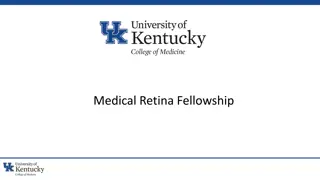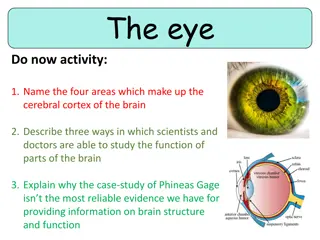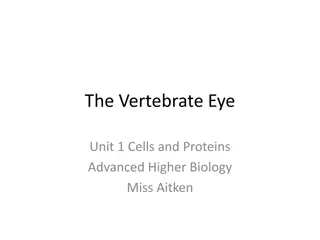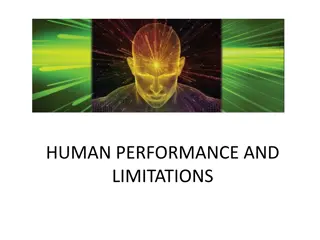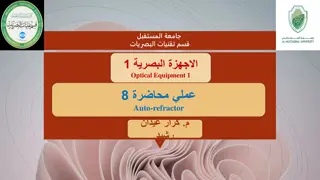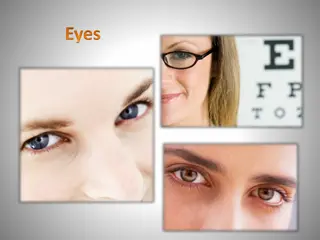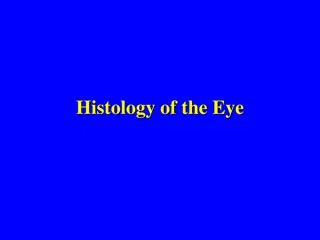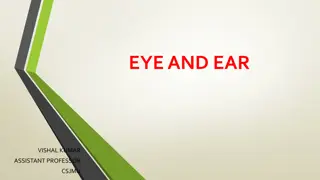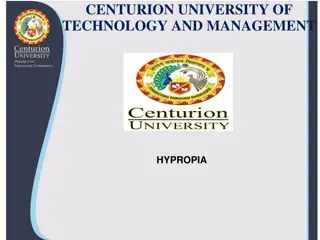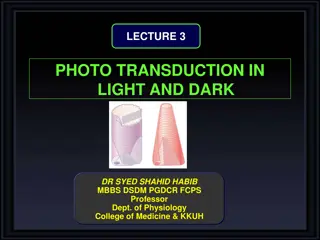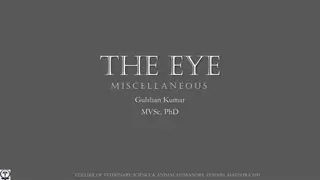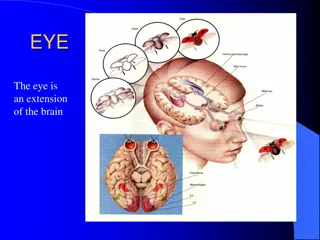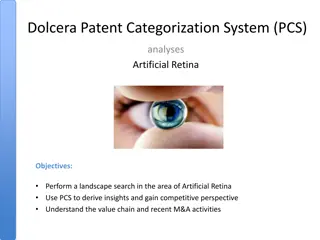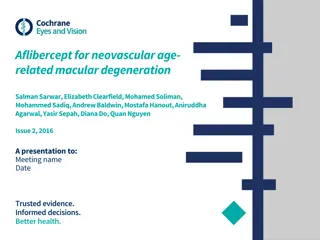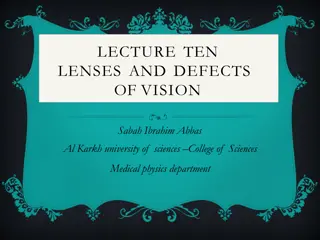Comprehensive Medical Retina Fellowship Program at UK Medical Campus - Clinical Training, Research, and Specialized Facilities
Strong clinical training in retinal diseases including uveitis and inherited disorders, emphasis on research, distinguished faculty members, structured schedule with clinics and academic activities, state-of-the-art facilities and equipment for specialized testing and imaging.
2 views • 14 slides
Understanding the Anatomy and Function of the Eye
This comprehensive health assessment explores the intricate structures of the eye including the sclera, cornea, iris, retina, and optic disc. It delves into the visual pathways, accessory structures like eyelids and lacrimal glands, and special considerations like age and ethnicity. The visuals prov
0 views • 39 slides
Understanding the Structures and Functions of the Eye
Explore the main structures of the eye including the iris, lens, cornea, retina, and more. Discover how these components work together to facilitate vision and light focusing. Engage in activities to enhance your knowledge of eye anatomy and function.
0 views • 20 slides
Exploring the Intricacies of Vertebrate Eye Biology
Delve into the fascinating world of vertebrate eye biology with a focus on the retina, rods, cones, and the intricate mechanisms involved in light detection. Learn about photoreceptor cells, rhodopsin, photopsins, and the pathways that lead to nerve impulse generation in response to light stimuli.
0 views • 13 slides
Understanding Astigmatism and Its Types
Astigmatism is a common refractive error where light entering the eye fails to focus on the retina, resulting in blurred vision. This condition is characterized by variations in the shape of the cornea or lens, leading to disturbances in vision. There are two types of astigmatism: regular and irregu
4 views • 33 slides
Understanding Human Vision and Eye Function
Human vision is essential for many tasks, especially in professions like aviation maintenance technicians. Proper lighting and eye protection are crucial for optimal vision. The eye functions like a camera, with components including the cornea, iris, lens, and retina. Each part plays a vital role in
0 views • 36 slides
Understanding Auto-refractors in Optical Equipment
An auto-refractor is an automated system that uses light reflected off the retina to measure a patient's refractive error objectively. This technology is fast, safe, and easy to use, providing accurate prescriptions without the need for pupil dilation. While children may find it challenging to sit s
0 views • 15 slides
Fascinating Insights into the Functioning of Eyes and Cameras
Explore the intriguing similarities between the working mechanisms of human eyes and cameras. From capturing images to processing them, discover how our eyes serve as the ultimate biological cameras, sending visual information to the brain for interpretation. Delve into the intricate components of t
0 views • 10 slides
Understanding the Science of Color Perception
Objects appear colored due to selective reflection of light wavelengths - some are absorbed, and the rest are reflected. The eye's complex structure, including the cornea, iris, pupil, lens, and retina, plays a crucial role in perceiving color. Color blindness results from missing cone cells in the
0 views • 9 slides
Histology of the Eye: Structure and Function Overview
Explore the histology of the eye, covering the general structure and the microscopic details of the cornea and retina. Learn about the three coats of the eye bulb, including the fibrous, vascular, and neural tunics. Dive into the composition of the cornea, from its transparent and highly innervated
0 views • 24 slides
Understanding the Human Eye: Structure and Function
The human eye is a remarkable optical system that functions like a camera, with components such as the cornea, lens, and retina working together to form images that are perceived and interpreted by the brain. The structure of the eye, including the cornea, iris, lens, and retina, plays a crucial rol
0 views • 7 slides
Understanding Color Blindness: Causes, Symptoms, and Types
Color blindness, also known as color vision deficiency, is a genetic disorder that affects the ability to distinguish between certain colors. It is caused by the absence of color-sensitive pigment in cone cells of the retina, often passed down on the X chromosome. Symptoms vary from difficulty diffe
1 views • 16 slides
Mutations in Coenzyme Binding Sites and Related Diseases
Mutations in coenzyme binding sites can lead to diseases by impacting enzyme affinity and reaction rates. Defects in proteins like ornithine aminotransferase and cystathionine-synthase result in conditions such as gyrate atrophy of the choroid and retina, homocystinuria, and X-linked sideroblastic a
0 views • 14 slides
Understanding Ametropia: Refractive Eye Conditions Explained
Ametropia refers to refractive errors in the eye such as myopia, hypermetropia, and astigmatism, where light rays don't focus correctly on the retina. This condition is influenced by corneal power, anterior chamber depth, crystalline lens power, and axial length. Hypermetropia, also known as hyperop
0 views • 25 slides
Exploring the Importance of Sight and the Anatomy of the Eye
Dive into the significance of the sense of sight, why it is crucial, and how the eye functions to process visual information. Discover the roles of different eye parts, such as the cornea, iris, retina, and optic nerve. Engage in experiments to understand how light affects the eyes and learn about t
0 views • 30 slides
Understanding Phototransduction in Vision: Rods, Cones, and Light Adaptation
This lecture delves into the intricacies of photo transduction in vision, focusing on the functional properties of rods and cones in different lighting conditions, the convergence of visual pathways, phototransduction processes in light and dark, synaptic mediators in the retina, and more. Explore t
0 views • 20 slides
Understanding Eye Disorders in Veterinary Science
Learn about various eye disorders in veterinary science such as amaurosis, refraction issues like hypermetropia and myopia, and conditions like astigmatism and diseases of the vitreous, retina, choroid, and optic nerve. Discover causes, symptoms, and treatments for these conditions. Images included
0 views • 5 slides
Exploring the Intricacies of the Human Eye and its Functions
Delve into the fascinating world of the human eye, an extension of the brain, as we explore its proximity to the optic nerve bundle and spinal cord. Understand the crucial role of the retina, lens, cornea, optic nerve, ciliary muscles, and suspensory ligaments in vision. Discover how the retina rece
0 views • 13 slides
Insights into Artificial Retina Technology through Dolcera Patent Categorization System
The Dolcera Patent Categorization System (PCS) analyzes the field of Artificial Retina, focusing on innovations to tackle blindness caused by conditions like macular degeneration and retinitis pigmentosa. The system conducts a landscape search using keywords related to Artificial Vision and Retinal
0 views • 12 slides
Effectiveness of Aflibercept for Neovascular Age-Related Macular Degeneration
This study compares the effectiveness and safety of intravitreal injections of aflibercept versus ranibizumab and bevacizumab for patients with neovascular age-related macular degeneration (AMD). Results show similar visual acuity outcomes and achievement of dry retina between aflibercept and ranibi
2 views • 14 slides
Understanding Digital Image Processing Fundamentals
This content provides insights into the essential aspects of digital image processing, focusing on elements of visual perception, the structure of the eye, image formation, brightness adaptation, and discrimination. Explore how the human visual system, akin to a camera, processes visual information
1 views • 8 slides
Understanding Lenses and Vision Defects in Medical Physics
Explore the fascinating world of lenses and vision defects in this detailed lecture from Sabah Ibrahim Abbas at Al Karkh University. Discover the properties of convex and concave lenses, how light refraction forms images, and the workings of the human eye with its cornea, iris, lens, and retina. Gai
2 views • 29 slides
